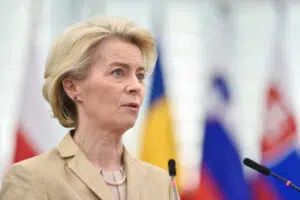Brussels – We are still a week away from the unveiling of the European defense package, but European Commission President Ursula von der Leyen is already putting on the table the foundational pillars of a strategy that is expected to change the future of security throughout the European Union. “Europe has started to grasp the urgency and the scale of the challenge that is ahead of us. But there is a lot more to do.And we need to move fast. The threat of war may not be imminent, but it is not impossible,” she warned MEPs as she opened the debate on European security and defense at the EU Parliament plenary session this morning (Feb. 28). The risks of war should not be overblown, but they should be prepared for. And that starts with the urgent need to rebuild, replenish and modernize Member States’ armed forces.” With joint procurement, more and better-coordinated funding, an ad hoc defense commissioner, an Office of Innovation in Kyiv, and the use of frozen Russian assets to support Ukraine’s armed struggle.

As indicated in the agenda of the College of Commissioners, the European defense industrial strategy meeting and the European Defense Investment Program (EoIP) are scheduled for Tuesday (March 5). After the first outline in recent weeks, von der Leyen wanted to give the Strasbourg hemicycle a glimpse of the most significant parts of a plan to “turbocharge our defense industrial capacity over the next five years.” The principle always remains “spend more, spend better, spend European,” as the central goal of the upcoming strategy will reflect: “Prioritize defense joint procurement. Just as we did it very successfully with the vaccines or for example with natural gas.” Brussels will focus on how to “facilitate offtake agreements [contracts whereby the manufacturer commits to sell at set prices and for a set number of years, ed] or advance purchase agreements where we provide guarantees” to ensure “stable and predictable long-term” orders for defense companies.
Increasing industrial production – “as we are now doing with ammunition through ASAP” -will be supported through “European defense projects of common interest, to focus efforts and resources where it has the biggest impact and added value” and to “ensure Europe has that edge in the new technologies.” The effort will be “European,” with an eye toward the Union’s present and future: “ I am proud to announce that we will set up an Office for Defence Innovation in Kyiv,” von der Leyen said, promising to “bring Ukraine ever closer to Europe and it will enable all Member States to draw on Ukraine’s battlefield experience and expertise in industrial defence innovation.” Speaking of the war in Ukraine, the top EU executive urged to “start a conversation about using the windfall profits of frozen Russian assets to jointly purchase military equipment for Ukraine,” calling it the best use for that money along with the rebuilding the invaded country.
Returning to the main thrust of the strategy for European defense, von der Leyen made it clear that this issue “needs undivided attention,” which is why the current chair of the EU executive – and candidate for a second term – said she is “personally supportive of a designated Defense Commissioner for the next Commission.” A crucial focus will be on access to capital and support with private financing, particularly for small and medium-sized enterprises, “the backbone of our industry and the engine of innovation.” Hence, the Commission’s appreciation of the
European Investment Bank (EIB) ad hoc plan: “I am very encouraged by the words of President (Nadia) Calviño….I really call now on Member States to endorse this proposal.” At this point, however, it remains clear, in von der Leyen’s view, that European sovereignty “will never affect the importance and the need for our NATO alliance” but, on the contrary, it “is vital to strengthen” the Atlantic Alliance (which with Sweden’s entrance now has 23 members in common). As seen by the fact that NATO is also aiming for increased investment in defense, with “18 of its member countries over the 2 percent target” of spending relative to GDP: “We are now spending more jointly on common capacities and projects between Europeans,” von der Leyen concluded.







